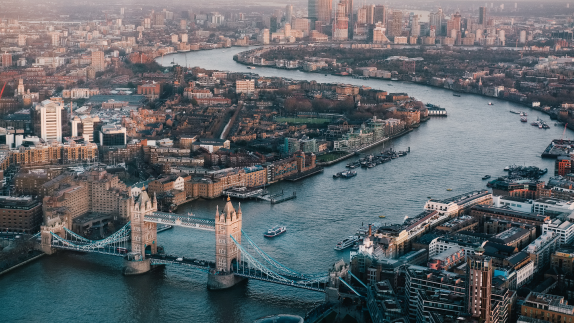What is a circular city?
A circular city has embedded the principles of the circular economycircular economyA systems solution framework that tackles global challenges like climate change, biodiversity loss, waste, and pollution. It is based on three principles, driven by design: eliminate waste and pollution, circulate products and materials (at their highest value), and regenerate nature. across the entire urban area. Everything is operating within an interconnected network of systems that are designed to eliminate waste and pollution, circulate products and materials, and regenerate nature. There’s collaboration between citizens, government, research facilities, and businesses. And the entire city is powered by renewable energyrenewable energyEnergy derived from resources that are not depleted on timescales relevant to the economy, i.e. not geological timescales..
In practice this means products, services, infrastructure, buildings, and vehicles are designed to be durable, adaptable, modular, easy to maintainmaintainKeep a product in its existing state of quality, functionally and/or cosmetically, to guard against failure or decline. It is a practice that retains the highest value of a product by extending its use period. and repurpose, and locally sourced. Everything can be composted, reused, or recycled. Nature is flourishing, abundant, and used as design inspiration. The result is a thriving local economy that provides a vibrant, liveable and resilient way of life.
Why cities are crucial to a circular economy
Cities have a high concentration of resources, capital, data, and talent spread over a relatively small geographic area and are centres for innovation. Because of this concentration, cities are also uniquely positioned to support certain circular business models, such as sharingsharingThe use of a product by multiple users. It is a practice that retains the highest value of a product by extending its use period. models, reusereuseThe repeated use of a product or component for its intended purpose without significant modification. systems or product-as-a-service models.
Two-thirds of us will be living in urban areas by 2050. Despite taking up just 2 per cent of global landmass, our urban centres consume more than 75 per cent of natural resources, are responsible for over 50 per cent of solid waste and emit up to 60 per cent of greenhouse gases, contributing to pollution, climate change and biodiversity loss.
Developments in circular manufacturing, fashion, transport, food and procurement are already being led from urban areas. Now is the time to take full advantage of the wealth of opportunities in cities to create a system that can work long-term for the economy, society, and the environment.
Use our resources and examples to find out how we can re-imagine cities as vibrant systems that operate public services more efficiently, improve how buildings are used, re-imagine city transport and more.
Examples
Circular business support programme for SMEs in London
ReLondon’s Business Transformation programme is nurturing a vibrant ecosystem of circular businesses, supporting jobs and resilient economic growth in London.
Small- and medium- enterprises (SMEs) are part of the fabric of London, and they are key to accelerating the city’s transition to a circular economy. ReLondon’s SME support programme Business Transformation helps companies either adopt circular practices, or – if they already have a circular business model – mainstream and scale their business. Since 2017, ReLondon has offered advisory and matchmaking services to over 350 SMEs and supported the launch of more than 80 circular products, processes or services.





